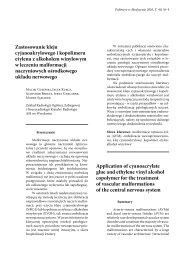Locust bean Gum as Superdisintegrant - Polimery w Medycynie
Locust bean Gum as Superdisintegrant - Polimery w Medycynie
Locust bean Gum as Superdisintegrant - Polimery w Medycynie
You also want an ePaper? Increase the reach of your titles
YUMPU automatically turns print PDFs into web optimized ePapers that Google loves.
TABLETTING TECHNOLOGY<br />
Porosity<br />
Porosity is a me<strong>as</strong>ure of the void spaces in a material,<br />
and is a fraction of the volume of voids over the<br />
total volume, between 0–1, or <strong>as</strong> a percentage between<br />
0–100 percent.<br />
The porosity of the tablets w<strong>as</strong> calculated <strong>as</strong> follows:<br />
m<br />
ε = 1 –<br />
ρ<br />
*<br />
V<br />
Where: ρ true is the true density of the mixture,<br />
m and V are the weight and volume of the tablet, respectively.<br />
The true density of the powder w<strong>as</strong> found using<br />
true density meter (SMART PYCNO 30). True density<br />
w<strong>as</strong> calculated using two pressure readings. Initially<br />
helium g<strong>as</strong> w<strong>as</strong> pressurised in a known reference<br />
volume. This reading w<strong>as</strong> taken <strong>as</strong> first pressure<br />
reading. Then the g<strong>as</strong> is allowed to p<strong>as</strong>s to sample cell<br />
containing the sample material. There is a drop in<br />
pressure <strong>as</strong> compared to initial pressure and this<br />
dropped pressure is taken <strong>as</strong> second pressure reading.<br />
Then material volume is calculated from which<br />
true density is calculated. When Helium is used initially<br />
vacuum is necessary to remove air from the<br />
pores of the sample. After that purging with Helium<br />
g<strong>as</strong> is done. Then the normal procedure is followed.<br />
true<br />
Tablet packing fraction<br />
The tablet packing fraction f should be in subscript<br />
is a me<strong>as</strong>ure of the degree of consolidation or<br />
compactness of the tablet. Tablet packing fraction<br />
w<strong>as</strong> determined by the following method:<br />
Packing fraction (P f ) = w/ πr 2 tρ<br />
Where: w is the weight of a tablet, r is radius, t is<br />
thickness and ρ is the particle density.<br />
Ten tablets were used in each me<strong>as</strong>urement. The<br />
radius and thickness of tablets were me<strong>as</strong>ured using<br />
a vernier calliper. The apparent particle density of<br />
the drug powder w<strong>as</strong> determined using liquid paraffin<br />
displacement method. Firstly, the weight of a specific<br />
gravity (SG) bottle filled with liquid paraffin<br />
and the weight of the SG bottle containing a sample<br />
of the drug powder (1 g accurately weighed) w<strong>as</strong> noted<br />
and then w<strong>as</strong> filled with liquid paraffin. The final<br />
weight w<strong>as</strong> determined. The determination w<strong>as</strong> executed<br />
in triplicate, and mean results were used in the<br />
calculation of Pf. If the packing fraction is very high,<br />
21<br />
fluid is unable to penetrate in the tablet which leads<br />
to slower disintegration [23].<br />
In vitro disintegration time<br />
Disintegration time for FDTs w<strong>as</strong> determined<br />
using USP disintegration apparatus with borate buffer<br />
(pH 8.4, 900 ml at 37°C) <strong>as</strong> the disintegrating medium.<br />
To comply the test all tablets should disintegrate<br />
within 3 minutes <strong>as</strong> per official requirements.<br />
In vivo disintegration time<br />
In vivo disintegration time w<strong>as</strong> judged in five<br />
healthy male volunteers for each batch of tablets. The<br />
volunteers were previously well-versed for purpose of<br />
the study. All the volunteers were instructed to rinse<br />
their oral cavity with distilled water prior to the test.<br />
Each volunteer w<strong>as</strong> <strong>as</strong>ked to place one tablet on the<br />
tongue and stopwatch w<strong>as</strong> started immediately. Volunteers<br />
were strictly told not to chew or swallow the<br />
tablets, licking w<strong>as</strong> allowed. The end point for disintegration<br />
w<strong>as</strong> taken when there were no lumps left in<br />
the oral cavity. After the test w<strong>as</strong> concluded, volunteers<br />
were told to rinse there mouth properly.<br />
Moisture uptake studies<br />
Orodispersible tablets usually contain high content<br />
of hydrophilic excipients which leads to incre<strong>as</strong>ed<br />
chances of moisture uptake, so they need special attention<br />
towards their storage and packaging. Therefore,<br />
moisture uptake studies are strongly recommended<br />
for orodispersible tablets [24]. The test w<strong>as</strong><br />
performed by keeping ten tablets in a desiccator (containing<br />
calcium chloride) for 24 hours at 37 o C to <strong>as</strong>sure<br />
complete drying. The tablets were then weighed<br />
and stored for 2 weeks at 75% humidity. A saturated<br />
solution of sodium chloride w<strong>as</strong> kept at the bottom of<br />
the desiccator for three days to achieve required humidity.<br />
On the tenth day tablets were re-weighed and<br />
the percentage incre<strong>as</strong>e in the weight w<strong>as</strong> recorded<br />
(Table 3).<br />
Drug content<br />
Twenty tablets were weighed and powdered. An<br />
amount of the powder equivalent to 100 mg of nimesulide<br />
w<strong>as</strong> dissolved in 100 ml of pH 8.4 alkaline bo-
















